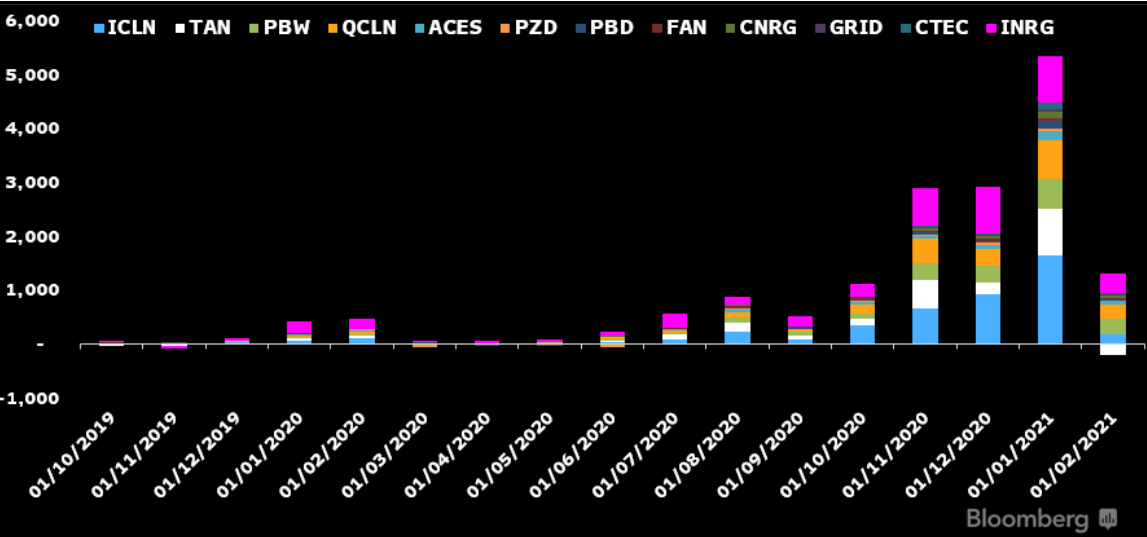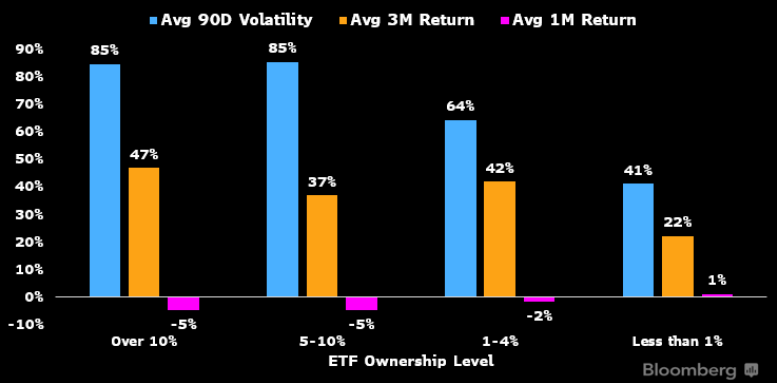In something of a perfect storm, oil market volatility and Joe Biden’s green recovery platform gave investors of all levels enough of a push to believe in the clean energy transition hype. ETFs acted as the ideal conduit for spreading capital across baskets of relatively unfamiliar equities – but now, amid concentration and liquidity risks, and the focus shifting to a recovery by any means necessary, can these strategies keep powering on?
The 12 clean energy ETFs in existence added more than $10bn in new assets in the three months to 22 February, according to Athanasios Psarofagis, ETF analyst at Bloomberg Intelligence, highlighting the significant demand for the megatrend. At their point of peak popularity in the four weeks to 1 January, this class of thematics saw $5.3bn inflows.

Source: Bloomberg Intelligence
Having been either stagnant or loss-making products for more than a decade, clean energy ETFs spent around 150 months struggling to hit even a tenth of the inflows they saw in January. Now, having roughly doubled in size since September 2020, the products had amassed more than $27bn in assets by the end of February 2021.
Small actors with big boots to fill
One issue, as reported by Société Générale and Bloomberg Intelligence among others, is these strategies are made up of relatively small companies, that simply cannot support the volume or speed of enthusiasm pouring into them. While clean energy ETFs hold less than a percent of around two-thirds of the 255 stocks that comprise them, they collectively own more than 5% of 44 of these stocks, and more than 10% of 23 of the companies.
These 23 companies have an average market value of $2.9bn, making them naturally small caps – even though their current market caps are inflated several times over by mass demand and an under-supply of clean energy equities ready to service this demand.
The effects of this trend can be seen in specific examples, such as Daquo New Energy and Beem Global, which both have more than 16% of their respective share capital owned by ETFs, and Canadian Solar, which is 19% held by clean energy ETFs. Likewise, Enphase Energy is held by eleven different clean energy strategies, while clean energy products have invested a combined $1.7bn in PlugPower alone.
The issues with this kind of over-concentration are twofold. On the one hand, there is the valuation argument, whereby over-inflated small caps never come close to generating earnings which make up even a fraction of the share capital invested in them.
Subsequently, there is the issue of volatility. As the clamour surrounding clean energy begins to lose some steam – as it has done in recent weeks – it becomes increasingly difficult to justify the meteoric rise in valuations of what are in essence small companies. The result of this is a feedback loop, whereby investors rush to sell off their clean energy ETF holdings, which deflates both the value of the strategies themselves and their underlying holdings, which likely sparks further investor flight.
This trend is not confined to a satisfyingly symmetrical thought experiment either, but has actually been illustrated in practice, with greater ETF ownership correlating with higher volatility, and recently, worse performance.

Source: Bloomberg Intelligence
With such dynamics becoming more apparent, professional onlookers fear the potential of ‘bubble-like’ behaviours.
In a recent post on ETF Stream, James McManus, CIO at Nutmeg, said the extent of investors piling into these strategies fundamentally changes the risk-reward equation of investing in their underlying theme. And, as such, McManus argued these kinds of concentrations have created a risk profile his company cannot ignore.
“We continue to believe that the clean energy sector is an attractive investment theme for the next decade as structural shifts fundamentally alter the global energy mix,” the CIO continued.
“However, given the strong performance and significant asset flows into a concentrated sector over the previous three months, we have removed these positions from our portfolios at the current time.”
The poster child
Of the ETFs involved in such trends, the most notable are BlackRock’s two clean energy ETFs, the iShares Global Clean Energy UCITS ETF (INRG) and the US-listed iShares Global Clean Energy ETF (ICLN).
INRG surged from $300m to over $7bn in 2020, while ICLN grew from $400m to a similar level of around $7bn during the same time period. Together, the two ETFs claim an estimated $14bn in assets – more than half of all global clean energy ETF assets – according to Peter Sleep, senior investment manager at 7IM.
Both products track the S&P Global Clean Energy index, which currently consists of 30 constituents. This means that INRG’s and ICLN’s $14bn assets are spread between just 30 relatively small companies.
As Sleep said: “What do you think happens when you suddenly throw $14bn at a limited group of small and mid-cap companies?
“These two ETFs own jointly 5% of Powercell – most of that bought last year with the massive increase in the size of the ETFs. Never mind all the other ETFs and other thematic funds buying. The market cap of this company rose from less than $1bn last year to nearly $35bn last month.
“PLUG is now owned 5% by these two ETFs. Vanguard owns another 8%."
Record demand for clean energy ETFs causing liquidity risks
Alan Miller, co-founder and CIO at SCM Direct, noted that more than 50% of INRG’s allocation is confined to just ten companies, and that the ETF recently traded at 36 times earnings.
“While its recent decline could be short-lived, I hope it gives investors pause for thought on the risks of investing on hype rather than fundamentals,” Miller said in response to the ETF’s recent dip.
Already aware of the concentration concerns being raised with its index, S&P Dow Jones Indices (SPDJI) is currently consulting with the market and is set to apply a more stringent liquidity screen, as well as increase the number of constituents from 30 to 35.
Biden and Black energy
Aside from the structural issues within clean energy products, investors would also be wise to question the sure-footedness of the assumptions upon which last year’s rallies were based.
As a first consideration, the election of Joe Biden acted as a boon for clean energy ETFs with the Democrat candidate promising to commit $2trn towards climate-related investments. Likewise, Biden said he would put the US on track to have a carbon-neutral power sector by 2025 and push the economy towards carbon neutrality by 2050.
While it would be premature to rule out the possibility that Biden follows through on some or all of these pledges, we can reasonably assume that they will play second fiddle to the coronavirus recovery.
Laying this out plainly was the $1.9trn stimulus bill recently passed by Congress, which does plenty by way of financial support for services and individuals, but little for the clean energy transition. While this was to be expected, Biden said the relief bill was historic and costly – investors should therefore temper their optimism for ambitious clean energy expenditure in the near future.
A second consideration is the pandemic has encouraged many to prematurely sound the death knell for fossil fuels. If the 15% oil price rises during February tell us nothing else, they should let us know that manufacturers, transportation and service providers are expecting an economic recovery.
How long can energy ETFs keep the lights on?
The speed of this recovery bears greater salience than the fuels used to power it, and, if the recent uptick in oil prices are anything to go by, economies across the world will focus more on the convenience than the cleanliness of their energy sources – at least in the coming months.
Not all doom and gloom
Despite fossil fuels being given a lease of life in 2021, and natural gas likely to enjoy an expanded role as a ‘lesser of evils’ alternative in years to come, most remain positive about the secular picture for the clean energy transition.
Kenneth Lamont, senior analyst, manager research, passive strategies, at Morningstar, said the pandemic acted as an important inflection point for many of the assumptions investors have about the energy sector.
“Given our need to build a fossil fuel-free future, the longer-term growth potential of these strategies make them compelling investment propositions,” Lamont continued.“We expect this market to grow in breadth and size in the coming years.”
Meanwhile, Omar Moufti, iShares sector and thematic ETFs product specialist at BlackRock, added: “While we think the energy sector on the whole faces structural headwinds, the clean energy subsector is well-positioned to capture the increased focus on sustainability in the coming years.”
From an ETF point of view, changes such as the SPDJI adding constituents to its index may not be a panacea, but at least show that key participants are active and willing to make changes to clean energy strategies where necessary.
Furthermore, as energy blue chips like BP and Shell continue their transition to renewable power generation, it will only be a matter of time before they acquire some of the companies included in clean energy indexes, and eventually get included within clean energy indexes themselves. Should this come to fruition, ETFs would not face the same kind of concentration risks they currently face with their small-cap constituents.
Greener pastures elsewhere?
For those still convinced by clean energy thematics, it may be worth looking beyond mainstays like INRG. Even with its underlying index extending to 35 companies, this is still far more concentrated than the clean energy ETF average of 47, according to Bloomberg Intelligence.
Launching just a month after INRG, the First Trust Nasdaq Clean Edge Green Energy UCITS ETF (QCLU) tracks its underlying Nasdaq index featuring 44 constituents and charges a net expense ratio of 0.60% – below INRG’s fee of 0.65%.
A key concern with this strategy is it has a 8.9% weighting to Tesla and has a 6.9% allocation in NIO meaning investors will be exposed to two of the world’s most volatile EV hype stocks.
Another worthy option is the L&G Clean Energy UCITS ETF (RENW). RENW is more diverse than INRG in two different aspects. Not only is its 29.9% US focus 12.5% less than INRG’s, but like QCLU, RENW also has 44 constituents. Also appealing is RENW’s fee of 0.49% before transaction costs, 16bps lower than INRG and 11bps below QCLU.
Finally, Invesco very recently launched its own clean energy gambit in Europe, by way of the Invesco Global Clean Energy UCITS ETF (GCLE). While charging a premium versus RENW, with a total expense ratio (TER) of 0.60%, GCLE’s edge is in its diversification, with the ETF offering exposure to a basket of 117 companies.











